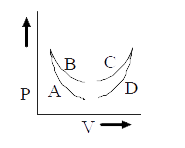How is energy exchanged between the system and the surroundings in the form of
(i) heat (ii) work?
To understand how energy is exchanged between a system and its surroundings in the form of heat and work, we can break it down into two distinct parts:
Step 1: Understanding Heat Exchange
- Heat is the energy transferred between a system and its surroundings due to a temperature difference.
- When two objects at different temperatures come into contact, heat flows from the hotter object to the cooler one until thermal equilibrium is reached.
- Example: When you touch ice, the heat from your body (which is at a higher temperature) transfers to the ice (which is at a lower temperature), causing you to feel cold.
Step 2: Understanding Work Exchange
- Work is the energy transferred when a force is applied to move an object.
- In thermodynamics, work can be done by the system on the surroundings or vice versa.
- Example: When you walk, your muscles exert a force that moves your body against the gravitational force, which is a form of work being done.
Step 3: Summary of Energy Exchange
- Energy exchange can occur in two primary ways:
1. Heat: Transfer of energy due to temperature differences.
2. Work: Transfer of energy due to mechanical or physical processes.
- Heat is the energy transferred between a system and its surroundings due to a temperature difference.
- When two objects at different temperatures come into contact, heat flows from the hotter object to the cooler one until thermal equilibrium is reached.
- Example: When you touch ice, the heat from your body (which is at a higher temperature) transfers to the ice (which is at a lower temperature), causing you to feel cold.
- Work is the energy transferred when a force is applied to move an object.
- In thermodynamics, work can be done by the system on the surroundings or vice versa.
- Example: When you walk, your muscles exert a force that moves your body against the gravitational force, which is a form of work being done.
- Energy exchange can occur in two primary ways:
1. Heat: Transfer of energy due to temperature differences.
2. Work: Transfer of energy due to mechanical or physical processes.
Topper's Solved these Questions
- THERMODYNAMICSBOOK - MODERN PUBLICATIONCHAPTER - THERMODYNAMICSEXERCISE - Revision Exercise (Long Answer Questions)
11 Videos
- THERMODYNAMICSBOOK - MODERN PUBLICATIONCHAPTER - THERMODYNAMICSEXERCISE - Revision Exercise (Numerical Problems)
10 Videos
- THERMODYNAMICSBOOK - MODERN PUBLICATIONCHAPTER - THERMODYNAMICSEXERCISE - Revision Exercise (Short Answer Questions ) (Fill in the blanks : )
5 Videos
- STRUCTURE OF ATOMBOOK - MODERN PUBLICATIONCHAPTER - STRUCTURE OF ATOMEXERCISE - Unit Practice Test
13 Videos
Similar Questions
Knowledge Check
Work done by the system on surroundings is :
APositiveBNegativeCZeroDNoneAssertion : During an adiabatic process, heat energy is not exchanged between system and its surroundings.
Reason : The temperature of a gas increases when it undergoes andn adiabatic expansion.AIf both the assertion and reason are true and reason is correct explanation of the assertion .BIf both the assertion and reason are true but reason is not a correct explanation of the assertion .CIf the assertion is true but the reason is false.DIf both assertion and reason are false.In open system, system and surroundings exchange
AEnergy onlyBMatter onlyCEnergy and matterDNeither energy nor matter
During a process, the internal enegry of the system increases by 240kJ while the system performed 90kJ of work on its surroundings. How much heta was transferred between the system and the surroundings during this process. In which direction did the heat flow?
View SolutionIn reference of above figure, no heat exchange between the gas and the surrounding will take place if the gas is taken along -

View SolutionExplain given cases related to energy transfer between the system and surrounding –
energy transferred (Q) < 0
View SolutionNo heat flows between the system and surroundings. Then the thermdynamic process is
View SolutionNo heat flows between the system and surrounding. Then, the thermodynamic process is
View Solution
